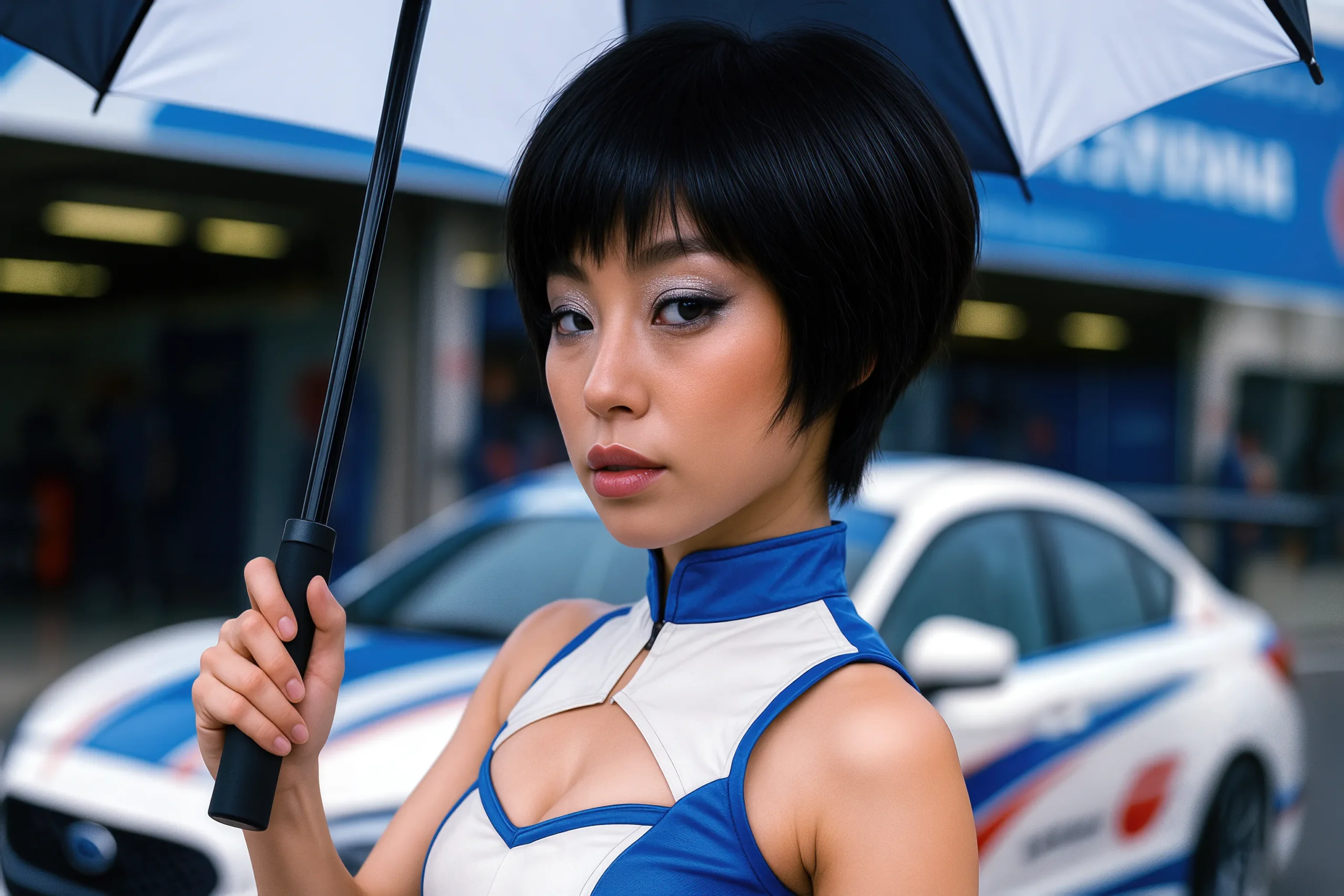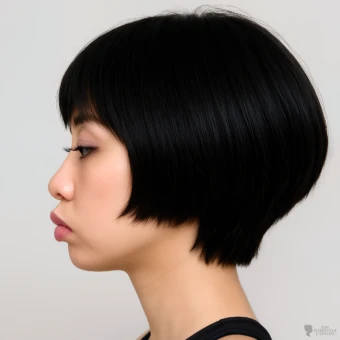Textured Mushroom Bob – The Chic, Modern Haircut That Redefines Elegance and Confidence
Summary
The textured mushroom bob is a modern twist on the classic mushroom‑shaped bob haircut. This short style features a domed crown that hugs the head and hair that is cut to roughly the same length all around, producing a rounded silhouette that resembles the cap of a mushroom. In its textured form, the cut uses layers, choppy ends and undercutting to add movement and prevent the style from looking too solid. The result is a wearable, feminine haircut that frames the face, emphasizes the jawline and flatters straight or slightly wavy hair. Thanks to its sculpted shape and modern texturing, the textured mushroom bob has become one of the most‑requested short hairstyles in recent years, appealing to anyone looking for a chic, low‑maintenance look.
The Textured Mushroom Bob
A textured mushroom bob takes its cues from the classic mushroom bob, which is characterized by hair cut to a uniform length around the head to create a round “cap”. The classic version is smooth and bowl‑like; the textured variation softens that dome with careful layering and point‑cutting. Stylists typically keep the length at or just below the jawline, with the back slightly shorter to hug the nape. Layers through the crown remove bulk and allow the cut to “bloom” into a mushroom shape. Subtle undercutting at the nape helps the hair sit under rather than flaring out, and interior layers or razor‑cut ends add movement.
Fringe options vary. Many textured mushroom bobs feature a wispy or micro‑fringe to emphasize the round silhouette, while others use longer curtain bangs that blend into the sides. Color also accentuates the design; highlights or balayage placed around the top of the head enhance the mushroom‑cap effect and make the layers look more dimensional. Overall the style balances bold structure with softness: the silhouette is deliberately sculpted yet the textured ends keep it light and airy. Because the hair is cut to fall naturally into place and requires minimal styling products, the textured mushroom bob is relatively low‑maintenance.
Textured Mushroom Bob Hairstyle Overview
| Hairstyle Properties | |
|---|---|
| Hairstyle Category/Subcategory | Bob / Textured |
| Complexity | Moderate |
| Hairstyle Volume | Moderate Volume |
| Symmetry & Balance | |
| Texture Finish | |
| Parting/Hairline | |
| Bangs/Fringe Type | |
| Face Enhancements | |
| Hair Suitability | |
| Face Shape Suitability | |
| Hair Length Suitability | |
| Hair Structure Suitability | |
| Hair Thickness Suitability | |
| Hair Curl Pattern Suitability | |
| Hair Health Suitability | |
| Color Treatment Suitability | |
| Practicality | |
| Styling Difficulty | Intermediate |
| Time to Style | 15 to 20 minutes |
| Maintenance | Moderate (Requires Some Styling) |
| Durability | Up to 10 hours |
| Styling Methods | |
| Styling Tools | |
| Styling Accessories | |
| Other Properties | |
| Gender | |
| Age Group | |
| Occasion | |
| Cultural Origins | |
| Era of Popularity | |
| Special Tags | |
| In Collections | |
Origin, History & Cultural Influence
The roots of the mushroom bob lie in the mushroom cut or bowl cut, a style that has been common across cultures for centuries. As one hairstyling blog notes, the mushroom cut’s name comes from its resemblance to a mushroom cap; the original term “bowl cut” reflected the practice of placing a pot or bowl on the head and trimming hair around it. This utilitarian method produced a uniform line and was used historically in various societies. Depending on the culture, the look signalled either poverty (because it could be done at home) or neatness and thrift.
The bob cut itself became fashionable in the early twentieth century. Polish hairdresser Antoni Cierplikowski (Antoine de Paris) popularized a short bob around 1909 and said he was inspired by the story of Joan of Arc. In the 1920s he introduced the shingle cut that daring young women — known as flappers — and style icons such as Coco Chanel, Sarah Bernhardt and Greta Garbo adopted. The bob became a symbol of female independence and modernity; so many women demanded it that barbershops saw queues of clients waiting to have their long hair shorn.
During the mid‑1960s the bob returned to prominence when hairstylist Vidal Sassoon created sleek, geometric versions. Its resurgence coincided with the “mop‑top” Beatles haircut for men, and designers like Mary Quant and Jean Muir, actresses such as Nancy Kwan, and singers including Diana Ross & the Supremes wore variations of the style. In the late 1980s and early ’90s the bob again grabbed headlines when punk‑influenced performers such as Siouxsie Sioux and Corinne Drewery adopted it, and the cut achieved cult status when Uma Thurman’s character Mia Wallace sported a sharp bob in Pulp Fiction (1994).
The mushroom cut has its own pop‑culture moments. According to TheSalonGuy, the style gained popularity in the United States during the 1980s thanks to the punk rock band The Ramones, whose members wore the blunt, bowl‑shaped cut. Though originally associated with young men, women also embraced the look, particularly those attracted to low‑maintenance styles. Modern hairstylists have reinvented the mushroom bob with layers and texture to avoid the helmet‑like appearance of the original; some call this version a “textured mushroom bob” or “choppy mushroom bob”. This contemporary iteration embraces the vintage silhouette while adding movement and softness, reflecting current preferences for effortless, voluminous hair.
Cultural Impact
The mushroom bob’s history reflects broader cultural shifts. Its early adoption by flappers symbolized rebellion against restrictive gender norms in the 1920s. In the 1960s it aligned with mod fashion and youth culture, paralleling the Beatles’ mop‑top. The 1980s punk revival tied the cut to counter‑culture again, with The Ramones turning it into a unisex statement of rock‑and‑roll nonconformity. In modern times the textured mushroom bob appears on runways and social media as a nostalgic yet fresh look; stylists tout it as a low‑maintenance option that offers both edge and elegance. Its enduring appeal underscores how a simple, rounded haircut continues to evolve with changing aesthetics while remaining an emblem of individuality and modernity.
Styling Instructions
The Textured Mushroom Bob is a precise yet soft cut that relies on a balanced round silhouette with layered texture for movement. It’s best achieved on straight or slightly wavy hair, and while it can be done at home with some experience, the haircut’s structure makes it a style most suited for professional stylists.
Step-by-Step Instructions
-
Preparation and Sectioning
-
Start with freshly washed, towel-dried hair. Apply a lightweight volumizing mousse or texturizing spray for grip and control.
-
Divide the hair into sections: top, sides, crown, and nape. Secure each section with clips to ensure even cutting.
-
-
Creating the Base Shape
-
Begin at the nape of the neck and cut horizontally, following the natural curve of the head.
-
Work upward in small sections, maintaining a consistent rounded line that gently frames the neck.
-
Use the point-cutting technique to soften the edges and avoid a heavy bowl-like appearance.
-
-
Building the Volume and Texture
-
Move to the crown area and create slight graduation to build volume.
-
Blend the layers seamlessly into the back and sides using a texturizing shear or razor.
-
Ensure the front sections curve inward slightly toward the face for a feminine contour.
-
-
Defining the Fringe (Optional)
-
If adding a fringe, cut it just above the brows or leave it longer and tapered for a softer look.
-
Blend the fringe into the sides to keep the hairstyle cohesive.
-
-
Blow-Drying and Shaping
-
Blow-dry the hair with a round brush, lifting from the roots to emphasize the rounded shape.
-
Direct the ends slightly inward to maintain the mushroom contour.
-
For added texture, finish with a diffuser or lightly tousle the ends with your fingers while drying.
-
-
Finishing and Styling
-
Apply a light texturizing pomade or matte wax through the ends to separate and define layers.
-
Mist with a flexible-hold hairspray to preserve movement while maintaining shape.
-
Professional Tips
-
Precision is key. The rounded silhouette requires careful sectioning and even cutting. A stylist should check the symmetry frequently using a mirror.
-
Avoid over-thinning. The style depends on fullness near the crown; excessive thinning can flatten the top and ruin the mushroom shape.
-
Adapt for face shape. For round faces, keep the length slightly below the jawline. For square or heart-shaped faces, add more layering and inward curvature at the ends.
-
Maintenance. Schedule trims every 4 to 6 weeks to preserve the clean outline and remove split ends.
-
Styling variation. A flat iron can create a sleek, polished version, while tousling with a salt spray gives a casual, modern edge.




